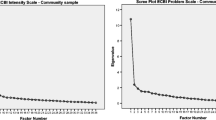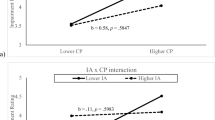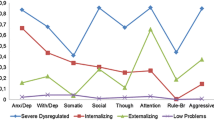Abstract
Parents or teachers rated 487 non-clinically referred young people with Pervasive Developmental Disorders on the Nisonger Child Behavior Rating Form. The objectives of the study were to examine the relative prevalence of specific behavior problems, assess the impact of subject characteristics, and derive an empirical classification of behavioral and emotional problems for this population. Results indicated that the youngsters experienced high rates of behavior and emotional problems. Cluster analysis suggested that six- and eight-cluster solutions best fit the ratings provided by parents and teachers, respectively. Both parent and teacher cluster solutions contained groups of children characterized as problem free, well adapted, hyperactive, anxious, and with undifferentiated behavior disturbances. The empirically derived clusters were supported by data external to the analyses.
Similar content being viewed by others
References
Aman, M. G., Lam, K. S., & Collier-Crespin, A. (2003). Prevalence and patterns of use of psychoactive medicines among individuals with autism in the Autism Society of Ohio. Journal of Autism & Developmental Disorders, 33, 527–534.
Aman, M. G., Tassé, M. J., Rojahn, J., & Hammer, D. (1996). The Nisonger CBRF: A child behavior rating form for children with developmental disabilities. Research in Developmental Disabilities, 17, 41–57.
American Psychiatric Association. (1994). Diagnostic and statistical manual of mental disorders (4th ed.): DSM-IV. Washington, DC: Author.
Arnold, L. E. (2000). Contemporary diagnosis and management attention-deficit/hyperactivity disorder. Newtown, PA: Handbooks in Health Care.
Bertrand, J., Mars, A., Boyle, C., Bove, F., Yeargin-Allsopp, M., & Decoufle, P. (2001). Prevalence of autism in a United States Population: The Brick Township, New Jersey, Investigation. Pediatrics, 108, 1155–1161.
Brown, E. C., Aman, M. G., & Havercamp, S. M. (2002). Factor analysis and norms for parent ratings on the Aberrant Behavior Checklist-Community for young people in special education. Research in Developmental Disabilities, 23, 45–60.
Brown, E., Aman, M. G., & Lecavalier, L. (2004). Empirical classification of behavioral and psychiatric problems in children and adolescents with mental retardation. American Journal on Mental Retardation, 109, 445–455.
Bruininks, R. H., Woodcock, R. W., Weatherman, R. F., & Hill, B. K. (1996). Scales of independent behavior – revised: Manual. Boston: Riverside Publishing Company.
Bryson, S. E., & Smith, I. M. (1998). Epidemiology of autism: Prevalence, associated characteristics, and implications for research and service delivery. Mental Retardation and Developmental Disabilities Research Reviews, 4, 97–103.
Einfeld, S. L., & Tonge, B. J. (2002). Manual for the developmental behaviour checklist (2nd ed.). Clayton, Melbourne, and Sydney: Monash University Center for Developmental Psychiatry and School of Psychiatry, University of South Wales.
Fergusson, D. M., & Horwood, J. (1995). Predictive validity of categorically and dimensionally scored measures of disruptive childhood behaviors. Journal of the American Academy of Child and Adolescent Psychiatry, 34, 477–487.
Gadow, K. D., DeVincent, C. J., & Azizian, A. (2004). Psychiatric symptoms in preschool children with PDD and clinic and comparison samples. Journal of Autism and Developmental Disorders, 34, 379–393.
Gadow, K. D., DeVincent, C. J., Pomeroy, J., & Azizian, A. (2005). Comparison of DSM-IV symptoms in elementary school-aged children with PDD versus clinic and community samples. Autism, 9, 392–415.
Gillberg, C., & Billstedt, E. (2000). Autism and Asperger syndrome: Co-existence with other clinical disorders. Acta Psychiatrica Scandinavica, 102, 321–330.
Hammer, D., & Lecavalier, L. (2003). Successful models and demonstration projects in autism spectrum disorders. Columbus, OH: Ohio Department of Education.
Kamphaus, R. W., Huberty, C. J., DiStehano, C., & Petoskey, M. D. (1997). A typology of teacher-rated child behavior for a national U.S. sample. Journal of Abnormal Child Psychology, 25, 453–463.
Kamphaus, R. W., Petoskey, M. D., Cody, A. H., Rowe, E. W., & Huberty, C. J. (1999). A typology of parent rated child behavior for a national U.S. sample. Journal of Child Psychology and Psychiatry, 40, 607–616.
Lainhart, J. E. (1999). Psychiatric problems in individuals with autism, their parents and siblings. International Review of Psychiatry, 11, 279–298.
Lecavalier, L. (2005). An evaluation of the Gilliam Autism Rating Scale. Journal of Autism and Developmental Disorders, 35, 795–805.
Lecavalier, L., Aman, M. G., Hammer, D., Stoica, W., & Matthews, G. L. (2004). Factor analysis of Nisonger Child Behavior Rating Form in children with autism spectrum disorders. Journal of Autism and Developmental Disorders, 34, 709–721.
Marshburn, E. C., & Aman, M. G. (1992). Factor validity and norms for the Aberrant Behavior Checklist in a community sample of children with mental retardation. Journal of Autism Developmental Disorders, 22, 357–373.
Milligan, G. W. (1996). Clustering validation: Results and implications for applied analyses (Working Paper Series No. 92–98). Columbus: Ohio State University, College of Business.
Milligan, G. W., & Cooper, M. C. (1987). Methodology review: Clustering methods. Applied Psychological Measurement, 11, 329–354.
Rojahn, J., Borthwick-Duffy, S. A., & Jacobson, J. W. (1993). The association between psychiatric diagnoses and severe behavior problems in mental retardation. Annals of Clinical Psychiatry, 5, 163–170.
Rojahn, J., & Helsel, W. J. (1991). The Aberrant Behavior Checklist in children and adolescents with dual diagnosis. Journal of Autism and Developmental Disorders, 21, 17–28.
Rojahn, J., Matson, J. L., Lott, D., Esbensen, A. J., & Smalls, Y. (2001). The Behavior Problems Inventory: An instrument for the assessment of self-injury, stereotyped behavior and aggression/destruction in individuals with developmental disabilities. Journal of Autism and Developmental Disorders, 31, 577–588.
Stevenson, J. (1989). Multivariate statistics: II. Using different types of multivariate statistics to identify types of psychopathology: Cluster analysis and multidimensional scaling. Nordisk Psykiatrisk Tidsskrift, 43, 325–332.
Sverd, J. (2003). Psychiatric disorders in individuals with pervasive developmental disorders. Journal of Psychiatric Practice, 9, 111–127.
Tassé, M. J., Aman, M. G., Hammer, D., & Rojahn, J. (1996). The Nisonger Child Behavior Rating Form: Age and gender effects and norms. Research in Developmental Disabilities, 17, 59–75.
Tassé, M. J., Morin, I. N., & Girouard, N. (2000). French canadian translation and validation of the Nisonger child behavior rating form. Canadian Psychology, 41, 116–123.
Tassé, M. J., Girouard, N., & Morin, I. N. (1999). La grille d’évaluation comportementale pour enfants Nisonger: manuel de l’utilisateur. Département de psychologie, Université du Québec a Montréal .
Tonge, B. J., & Einfeld, S. L. (2003). Psychopathology and intellectual disability: The Australian child to adult longitudinal study. In L. M. Glidden (Eds.), International review of research in mental retardation (vol. 26, pp. 61–91). San Diego, CA: Academic Press.
World Health Organization. (1992). The ICD-10 Classification of Mental and Behavioural Disorder. Clinical descriptions and diagnostic guidelines. Geneva: World Health Organization.
Yeargin-Allsopp, M., Rice, C., Karapurkar, T., Doernberg, T., Boyle, C., & Murphy, C. (2003). Prevalence of autism in a US metropolitan area. Journal of the American Medical Association, 289, 49–55.
Acknowledgments
This research was supported in part by funding from the Ohio Department of Education. The author wishes to thank all the project coordinators, teachers, and parents for their cooperation. He is especially grateful to Shiling Ruan and Tom Bishop for their assistance with statistical analyses and to Michael G. Aman for comments on earlier versions of the manuscript.
Author information
Authors and Affiliations
Corresponding author
Rights and permissions
About this article
Cite this article
Lecavalier, L. Behavioral and Emotional Problems in Young People with Pervasive Developmental Disorders: Relative Prevalence, Effects of Subject Characteristics, and Empirical Classification. J Autism Dev Disord 36, 1101–1114 (2006). https://doi.org/10.1007/s10803-006-0147-5
Published:
Issue Date:
DOI: https://doi.org/10.1007/s10803-006-0147-5




